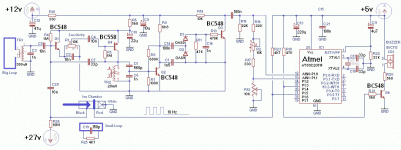Rudy(CA) said:
Before getting to the circuit details JP, I feel we ought to further explore and firm up the "physics" behind these ions.
I think we can agree that the device could not directly detect a gold ion as the ions would not be floating in air and certainly not at a distance
that would qualify the device as an LRL. Therefore, if anything, what it would have to detect (with some kind of directionality) is some kind
of electromagnetic wave that is characteristic of the desired metal (e.g. gold).
_________________________________
An aside on your allusion to a carbon arc lamp:
Unless the machine is supposed to work only during a thunderstorm, where does the energy needed to create the plasma come from?
Carbon arc lamp like energies are not common events outside of such storms. Besides, the ions created by such an event would have
relatively short life times before becoming neutral again. So, if you wait for the thunderstorm to pass by, by the time you get there all
the ions would be gone.
_________________________________
Now, if we go micro scale, the shedding or replacing of an electron in a gold atom. The energy required or given up in the process is the Work function and for gold it is 5 eV or about 8X10^-19 Joules of energy.
Using the well known formula E= hc/λ and solving for λ we get λ=hc/E which gives us a photon wavelength of 0.248 µm. The frequency
is, of course, the reciprocal of the wavelength and it is around 4 MHz. This is nowhere in the pico/femto/atto range claimed. Of course, it is not necessarily a steady stream of photons since only one photon is emitted (or absorbed) for each atom's transition. A transition in one direction emits a photon while a transition in the other direction absorbs it.
It is however in the frequency range of the schematic presented.
Hi Rudy,
Yes, I verified work function the for gold in the CRC handbook, which is listed at 5.1 to 5.47 electron volts depending on the lattice structure. And this does indeed result in a range of 4 MHz, which is in the frequency range of that circuit. So the speed of common signal transistors is no longer a problem when we consider a real wavelength that we can count on when a gold ion neutralizes.
But now I have another problem. This is claimed to be a classifying circuit which is calibrated to detect only gold. The problem is the frequency that results from a gold ion neutralizing is in the same exact range as for carbon, platinum, palladium, nickel, iridium, and cobalt. This means if it is resoponding to the frequency you derived from the energy used to neutralize a gold ion, it would find any one of those elements as well as gold. I wouldn't mind finding most of these things by accident, except for carbon. I have a suspicion that carbon ions are WAY more plentiful than gold ions, and they use an identical amount of energy to neutralize or ionize, resulting in an identical frequency. It could mean digging up hundreds of pounds of plant roots, burrowing rodents, bugs, decaying wood, coal, Hmmmm.... Ok so if I found a coal mine or oil well maybe that would work for me.
But that's not the only problem. The other problem is I don't see anything in the circuit that could identify a 4 mhz frequency related to this neutralizing of a gold ion. (or carbon ion, etc.) Unless we consider it is a static detector which has some working mechanism to identify the λ of gold ionizing (ion chamber?).
Let's take a look at what they claim about the ion chamber...
"We needed to produce the phenomenon of "micro crash" "nano crash" or below... It was invented not just as a classifier - "filter", but as a generator of positive "ions", receiver of negative ions, in order to [cause] a short-circuit to occur, and generator of electrostatic".
Ok, they are claiming ions are generated inside this cylinder which has a +5v 10 Hz pulse at the one end, and +27v steady DC at the pointed end, and a gold foil in the space about 5mm away from the point. It looks like the gold foil is positioned in voltage gradient at a point of +22.5 if we ignore the 5v pulsing at the other end.
is it possile for ions to form here?
Not in the manner that an ion generator works it cant. But what about working as an ion chamber?
This chamber looks suspiciously similar to some of the home made chambers on Charles Wentzel's page:
http://www.techlib.com/science/ion.html#Even Simpler Version
I should point out there is a grounded metal foil wrapped around the Mineoro PVC pipe to complete the "tin can" geometry like we see in these photos.
A simpler version can be found here:
http://dwarmstr.blogspot.com/2007/07/simple-ion-chamber-to-measure.html
On this page we see a tin can with a wire inside shows readable signals that will double from the 4.8mv null reading to 9.1mv when an alpha source is placed nearby. What is interesting is he gets this signal using a 36v supply with an air gap much larger than we see in the Mineoro chamber running at 27v. The gradient is obviously stronger in the Mineoro chamber, so we can expect it will perform ok as an ion chamber. It would seem there is some tiny quiescent state leakage signal which would become larger if something caused the air inside the chamber to become ionized.
So how is this ionization chamber related to distant gold ions neutralizing?
We read where Mineoro says
"Through electrostatic, the "ions" walk long distances, as if along an invisible wire". It would be absurd to think that a gold ion in the distance could transport from it's location to inside the LRL and make an electronic signal in the circuit. So what kind of signal will come from the distant ion neutralizing? For a group of ions neutralizing, we are talking about an unbelievably small signal that cannot be detected even a millimeter away. But the Mineoro LRL is not a millimeter away, it is at long range distance. And the detecting equipment is an ion chamber which does not respond to ions neutralizing in the distance. An ion chamber responds to radiation creating ions inside the chamber, not to distant gold ions neutralizing. So how can the LRL detect a distant gold ion neutralizing?
The only answer remaining seems like a far stretch, but possibly there is some kind of radiation coming from the ground, or from the sky which passes through the area and sets off the ion chamber, and at the same time causes some ions where the treasure is to ionize. If this is happening, there is no transfer of signal from the treasure to the locator. But we do have an event where both the treasure and the ion chamber see an increase in ions at the same time. So in this scenario we could say the LRL is beeping when it is near a treasure. The problem is it will beep regardless which direction you point it, and it will beep even if the treasure is not there. so it will not be acting as a treasure locator, but as a radiation detector.
Then another corrolary scenario is when the radiation comes from the ground only near the treasure. (I got no idea why radiation would come from the source of the treasure, I am just supposing if it did). In this case the locator could act as a locator of the radiation if the geometry of sheilding influences on the ion chamber and the person holding the detector made the chamber more receptive to the radiation when pointed toward the treasure and radiation source.
A final problem with either of these radiation scenarios is how can this tiny ion chamber signal enter the circuit above it, considering the impedance of the transistor network it is trying to feed? The hobbyist said his chamber was barely able to to turn on his darlington pair so he could measure a signal.
To summarize, I have three questions:
1. If this machine is detecting the energy of a gold ion neutralizing, how can it determine the difference from other elements that show the same energy when their ions neutralize?
2. What in the circuitry can identify a gold ion neutralizing?
3. How can the ionization chamber send any kind of tiny signal to the circuit above when the impedance is not even close to a match? (Or am I wrong about this)?
Best wishes,
J_P









